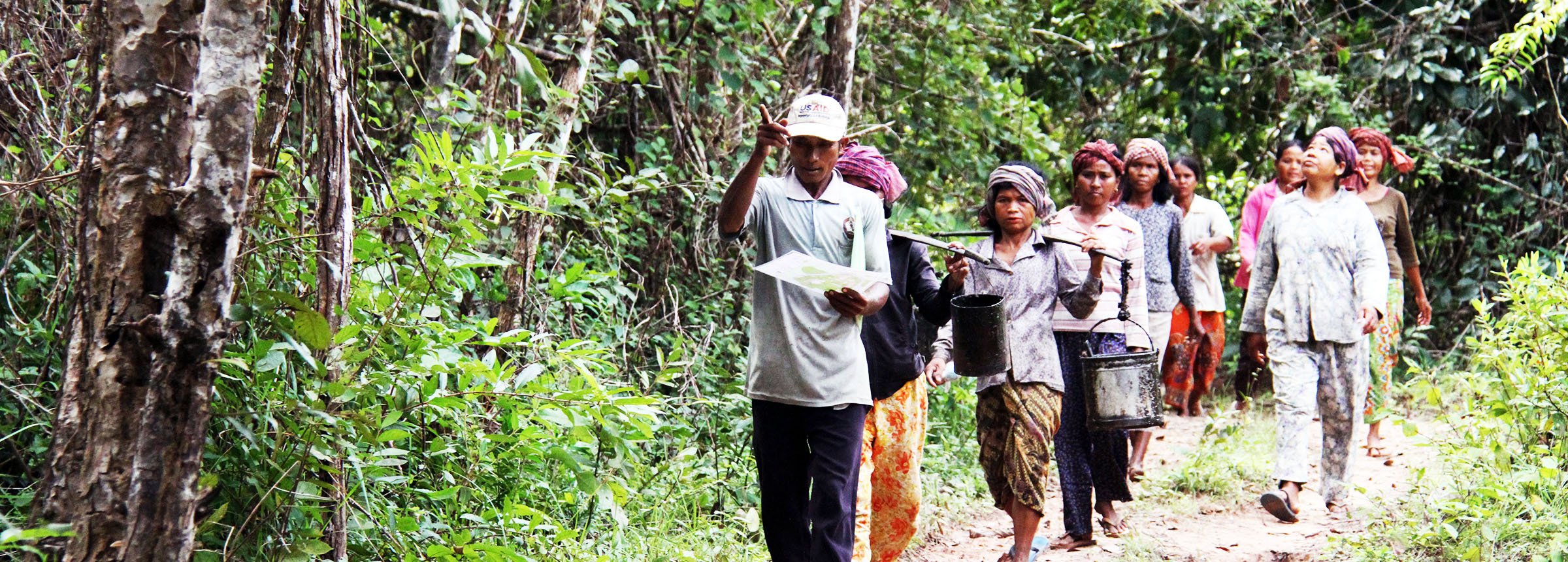
Windbreaks for Pacific Islands
Agroforestry for the Pacific Technologies
A publication of the Agroforestry Information Service
April 1993, Number 5
Windbreaks are single or multiple rows of trees planted to protect an area from prevailing winds. Windbreaks are planted along the windward boundaries of fields to provide a more favorable environment for crop growth. Windbreaks are also established to protect and improve the environments around homes, gardens, and villages.
Windbreaks are especially important on Pacific Islands where stiff trade winds blow throughout the year and tropical storms occur frequently. Salty maritime winds affect the most interior areas of exposed smaller islands.
Why slow the wind?
Wind can be very destructive, especially when combined with high temperatures, drought conditions, or salty sea air.
- Wind damages crops: Strong winds break stems, strip leaves, and tear fruit from crop plants.
- Wind sucks moisture from plants: When wind blows against crop plants, it dries the air immediately surrounding them. When this boundary air is dry, more moisture is pulled from the plant through transpiration. This is why plants wilt in high winds.
- Wind sucks moisture from the soil: Wind dries the soil surface, pulling moisture from soil pores.
- Wind carries salt: Along coastal zones and on small islands wind can and deposit tons of salt per hectare annually. In soil, salt draws moisture away from plants. Deposited on some plants, salt burns leaves and kills plant tissue.
- Wind affects the health/performance of livestock: Animals exposed to cold or hot winds can become stressed and much less productive.
- Wind affects human environments: Strong winds can disrupt or damage human households. Wind borne dust may be a human health hazard.
Because they slow the wind, windbreaks conserve plant and soil moisture, prevent crop damage, prevent soil erosion, and reduce salt-spray. They also enhance animal welfare/performance and create a more habitable environment for humans.
Windbreaks made up of well chosen multi-purpose tree species may also provide a variety of household and marketable products including fodder, fuelwood, timber, poles, fruit, mulch/compost, spices and medicine.
Windbreak Design
There are a few important windbreak design considerations:
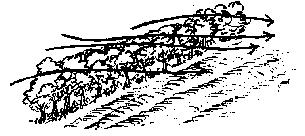
Orientation: Correct windbreak orientation is crucial. You should obviously plant your windbreak on the windward side of the land area or field you want to protect. You must also plant your windbreak in lines that are perpendicular to the prevailing wind direction. This may not be so obvious. If the wind direction changes from season to season you need to decide when it is most important to provide protection. This might be when the crop is most susceptible to wind damage, when the soil is exposed, or during the most windy season. In most Pacific locations, trade winds blow from a fairly constant direction so orientation should not be difficult or risky.
Multiple versus single row: To be most effective, your windbreak should include at least two rows of trees. This is because you want a wind barrier from the ground, up. Tall trees will protect a larger area of field, but they have high canopies and will thus leave an understory gap. Smaller trees are needed to this gap.

Effective windbreak/barrier
If you cannot sacrifice the land area that a multirow windbreak requires, plant a single row windbreak. A single row of trees can form a reasonable windbreak-and it is certainly better than nothing.
Windbreak height and between windbreak spacing: For every 1 m of height, your windbreak will protect 10 m of field area. A windbreak that is 10 m high will protect a field area 100 m downwind-so a windbreak 10 m high and 100 m long will protect a one hectare field.
Individual tree spacing and placement: Plant trees closely enough within rows so that tree mature tree crowns will overlap. The best spacing for medium sized trees is 3 to 4 m. Plant smaller trees at 2 to 3 m spacings and larger trees at no more than 6 m spacings.
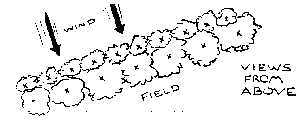
Individual tree/tree-row spacing and placement: You can use the same range for between row spacing. Again consider tree canopy size. Do not space the rows so closely that the larger row will shade-out the smaller row.
Always plant trees in each row so that they are in-line with gaps between trees of parallel rows. This staggering produces more effective windbreak sooner.
Species selection: You can plant your windbreaks with a variety of species. Obviously, trees used for windbreaks should be wind strong, and deeply rooted. The best species for windbreaks also have branching habits and relatively narrow crowns.
Choose species that are well adapted to your particular site and suited to your needs. if you need more fodder for your animals or fuelwood for your home, choose species tolerate strong winds while also yielding fodder and fuelwood. For consistency in height and ease of management, you should include only one species in each single row.
If you are able to plant a double or multi-row windbreak, choose smaller trees for the most windward row and medium to larger trees for the next row.
The area protected will be larger if the windbreak is partially permeable rather than too dense. This is because too dense a barrier can result in more turbulent air movement downwind. Some species make ideal windbreaks because their foliage filters rather than blocks the wind. The conifer like foliage of Casuarina is one example.
Grid design: This rather new windbreak technology is gaining popularity. Single row windbreaks are laid out in a grid pattern on a field creating several smaller cells or squares. This technique is especially effective where the wind often shifts direction.
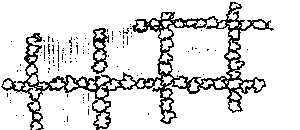
Windbreak Management
You will not necessarily have to manage your windbreak once it is established. Depending on the species you include however, you can prune, pollard, or otherwise treat trees in various rows to provide alternative products or maintain a more desirable height relative to other rows.
The management or harvesting practices you choose for each row will obviously influence the height and form of that row relative to the others. You should plan accordingly. For example, you can use shorter rows for things like fodder or fuelwood production because you will be pruning or pollarding them regularly. You can leave the taller rows alone to grow to their maximum height. You can also use the taller trees in ways that do not reduce their height for fruit, nut production.
Management treatments can affect a tree’s resistance to strong winds. Shoots that grow up from a pollarded stem, will be very susceptible breakage at the stem joint once they reach a certain size. If you pollard the most windward row of your windbreak for several years and then leave it alone to grow in height, sprouting branches will probably break in strong winds.
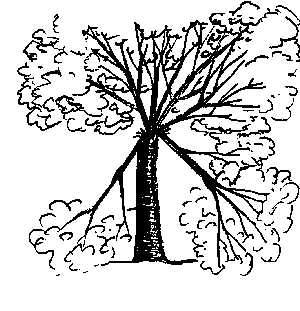
You can even harvest complete rows in you windbreak on a rotational basis if the trees are good timber producers. In this case, you would plant a new row to be functional at the time the mature row is harvested.
Problems/Limitations and Alternatives
Field boundary conflicts: It is unlikely that the ideal orientation for your windbreak will conform perfectly to your field boundary. If the boundary is nearly perpendicular to the prevailing wind, you can simply plant a windbreak as a form of boundary planting. If it is not, a boundary planting will not protect your crop from the wind. It may in fact, speed wind in your field because the wind may be forced along rather than against it. The most effective windbreaks are those that stretch across boundaries and are the cooperative efforts of a number of farmers.
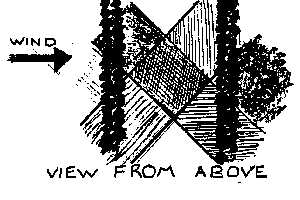
Loss of land: Windbreaks of two or more tree rows will take a substantial portion of your land out of crop production. Most successful windbreaks though, boost crop yields enough to compensate for this loss of area. Once your windbreak is in place, you may even be able to grow a more marketable or valuable crop/variety.
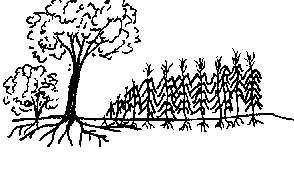
Competition with crops: Windbreaks may reduce the yield of crop plants in the area immediately next to them. This is due to competition for sunlight or water. Again, the increase in yield resulting in field interiors should compensate for this.
Pest problems: Some trees make nice homes for birds that will eat some crops especially grains.
The following are species which have proven themselves as effective windbreak components. They are grouped by typical size at maturity. For each, common additional uses are noted.
The species in bold are especially tolerant to salt spray.
Species with * asterisk are more shallow rooted and may blow over in typhoons.
|
Smaller trees Sesbania sesban-green manure, animal fodder Sophora tomentosa-fuelwood, nitrogen-fixing Tournefortia argentea-fuelwood, shade |
Medium size trees Acacia auriculiformis*-fuelwood, shade Acacia confusa-shade, firewood, nitrogen-fixing Acacia mangium-fuelwood, nitrogen-fixing Albizzia lebbeck*-timber, nitrogen-fixing Azadirachta indica (neem)- fuelwood, timber, insecticide Cassia fistula: fuelwood Casuarina equisetifolia-fuelwood, poles, nitrogen-fixing Erythrina poeppigiana-green manure, shade, nitrogen fixing Erythrina variegata-green manure, nitrogen-fixing Gliricidia sepium-green manure, animal fodder, fuelwood, nitrogen fixing Intsia bijuga-sturdy construction timber Melia azedarach-fuelwood, timber, tools, shade Pinus caribaea-timber, shade Pithecellobium dulce-fuelwood, animal fodder |
Taller trees Calophyllum inophyllum-boat timber, lamp-oil, shade, medicine Cassia siamea-fuelwood, small timber, animal fodder (toxic to pigs), edible leaves & flowers Cordia alliodora-timber Cordia subcordata-timber, edible seed Tamarindus indica (tamarind)- edible pods, charcoal, animal fodder, nitrogen-fixing |
Written by K.R. Dalla Rosa, Program Director for the Pacific, NFTA, 1010 Holomua Road, Paia, Hawaii 96779 USA
A publication of the Forest, Farm, and Community Tree Network (FACT Net)
Winrock International
Email: forestry@msmail.winrock.org
